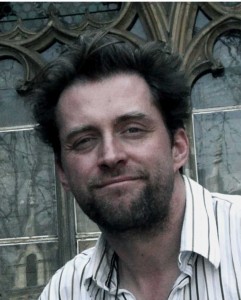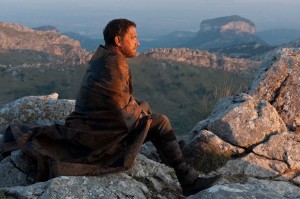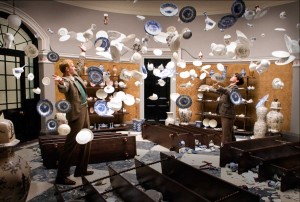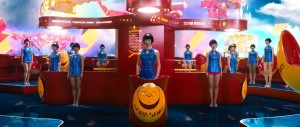
In Cloud Atlas everything is connected. And that’s exactly how directors Lana and Andy Wachowski and Tom Tykwer envisioned the intrepid film featuring an elaborate ensemble cast and six different storylines set in entirely different places and time periods.
To create six worlds the directors divided up the stories. The Wachowski siblings tackled the segments set in 1849, 2144 and 2321 and enlisted production designer Hugh Bateup, whom they also teamed up with for The Matrix trilogy. Tykwer took the stories set in 1936, 1973 and 2012 and collaborated with German production designer Uli Hanisch, who has previously designed for the director on The International (2009) and Perfume: The Story of a Murderer (2006).
Bateup took on each segment with a different approach. The sequences set in 1849 had its obvious research based on a past that already exists. He studied the people from the Pacific Islands and New Zealand. The segment of “Neo Seoul” in 2144 had an entirely different basis. “The story was really straight out of Lana and Andy’s heads,” Bateup said. “We took those ideas and went through the process of refining, changing thoughts, throwing away, and bringing back a whole range of ideas. For me that was an extremely satisfying process.” The post-apocalyptic scenes in 2321 about Zachry (Tom Hanks), a tribesman surviving the hard times was actually rooted in the same past as the story set in 1849. “We started researching the peoples from the Pacific and New Zealand to start as a basis for the Zachry Story and the Ewing [1849] story,” Bateup explained. “The Zachry story is set in 2144 but has its roots in the Pacific islands back in the 1870s.”

“Trying to match a Spanish island in summer with a Saxony forest in autumn gave us a few moments of concern,” he said. But from the beginning of the shoot, Bateup encountered the magic of the film. He described his favorite memory: “We were into the first week of the shoot and on location. We all needed everything to go well. The budget for the film didn’t give a lot of time for misadventure. There were storms hovering around the mountains in Majorca, John Toll, our DP was waiting with Lana and Andy to get up in a helicopter. Seeing the clouds part on the mountains and then being able to get up and do the aerials was a fantastic relief. The shots we saw on rushes were fantastic.”

For Uli Hanisch the experience was just as special. “Cloud Atlas has been a wonderful thing to make, because it’s rather complicated to tell the story for each segment and for each period,” he said. “We realized how important it was to make it immediately clear for the audience where they are, and to find a connection within the stories.”
Hanisch devoted himself to the details like a master craftsman in storybooks. “I do believe in details,” he exclaimed. “A tea cup might become more important than a whole concept of a room sometimes. We had so many chances to play with meaning in props and it would take a long time to figure out all the countless hidden details we used and re-used and played with all over the place.” If spotting the actors transformed throughout the film is a game, then finding all the meaningful pieces of the production design is a nearly never-ending pastime. Hanisch divulged a few examples. “All the shops in the street behind Luisa Rey [1973] are representing one of the six stories by name and subject. The art exhibition were Luisa Rey gets a copy of the report she has been looking for is showing Maori sculptures from the village we have seen with Adam Ewing [1849] at the whipping scene. There was a painting showing a slave plantation in front of a bay with the ship from the Ewing story that came back two or three times in different stories and so on and so on.” You might have to pause the film to notice the abundant details in depth, but the beauty of the production design lies in the likely event that even at first viewing, at least a few things are noticed and connections are drawn, however vaguely.

Sometimes the pursuit of exacting details is a glorious kind of madness as in the tale of the china shop. “It’s just a very typical story of movie making to have to destroy an entire china shop for a short dream sequence,” Hanisch said. “But at the same time, that’s movie magic. We had a location on very short notice in Edinburgh with a beautiful tile floor, which was the main reason why we wanted to shoot there. After we tested smashing several cups, it was clear we were destroying the floor rather than the china. So we protected the floor with metal sheets which we had to paint over to make them look like marble again. All that was done overnight while the china was being brought over from our storage space in Berlin in a rush. It still wasn’t enough china and we had to flood the flea markets all over Scotland to find more and more china. It was a mess. But it was also one of the truly wonderful moments in the film. That’s why we like to do things like that again and again.”
Hanisch and Bateup have helped create an unforgettable film that is a complex puzzle on every side: actors reappearing in several roles as entirely different characters (including genders and ethnicities), multiple stories and timelines, and the Where’s Waldo of hidden references to the stories within stories found in the production design, because, after all, everything is connected.





